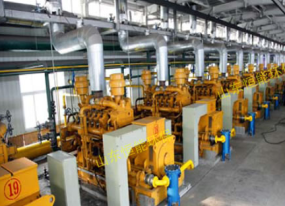控制鍋爐燃燒工況也是降低粉塵氮氧化物和二氧化硫排放的一種方法。當空氣進入爐膛當中時降低過量空氣的含氧量在一定程度上會起到限制區內氧濃度的上升。因而減少氧和硫,氧和氮氣的氧化反應,從而減少二氧化硫和氮化物的生成速度。但是過度控制氧量,一氧化碳會增加,對鍋爐燃燒有影響,從而影響鍋爐效率。還是要適當控制氧量,氧量越低二氧化硫和氮氧化物的排放量就越少;床溫也是影響二氧化硫和氮氧化物排放量的一個主要因素。每臺爐的工況都不一樣,我們運行的六#爐根據實踐總結,氧量控制到百分之三到四,床溫在850到950之間較科學,粉塵、氮氧化物、二氧化硫的排放比較低,而且不影響鍋爐效率(一般情況下,床溫保持在950左右是蕞佳狀態)。總體來說在鍋爐負荷穩定的情況下,控制鍋爐工況對脫硫脫硝控制是有幫助的。如果鍋爐負荷不穩定的情況下,氮化物和二氧化硫的排放量過多還是用氨水直投方法較快。
Controlling boiler combustion conditions is also a method to reduce the emission of dust nitrogen oxides and sulfur dioxide. When the air enters the furnace, reducing the oxygen content of excess air will increase the oxygen concentration in the restricted zone to a certain extent. Thus, the oxidation reaction of oxygen and sulfur, oxygen and nitrogen is reduced, so as to reduce the generation rate of sulfur dioxide and nitrides. However, if oxygen content is over controlled, carbon monoxide will increase, which will affect boiler combustion and boiler efficiency. The lower the oxygen content, the less sulfur dioxide and nitrogen oxide emissions; Bed temperature is also a major factor affecting SO2 and NOx emissions. The operating conditions of each boiler are different. According to the practice summary of the six \n\e boilers we operate, the oxygen content is controlled to 3-4%, the bed temperature is scientific between 850 and 950, the emission of dust, nitrogen oxide and sulfur dioxide is relatively low, and does not affect the boiler efficiency (generally, the bed temperature is kept at about 950). Generally speaking, under the condition of stable boiler load, controlling boiler working conditions is helpful for desulfurization and denitration control. If the boiler load is unstable and the emission of nitrogen compounds and sulfur dioxide is excessive, it is faster to use the method of direct ammonia injection.

脫硝入口氮氧化物變化大與燃燒調整煤質變化,氧量,一次風量,二次風量的控制有很大關系。脫硝平臺設立在旋風分離器的入口處,脫硝反應區的入口到出口的距離很短。如果入口氮氧化物上升快時,我們進行噴氨時要緩i慢的投入,因為氨和氮氧化物反應是有一定時間的滯后,那么反應就不會很完全,出口氮氧化物相應的上升后就會快速下降,如果投入過多,就會造成沒有完全反應的氨逃逸。氨逃逸危害是很大的,脫硝平臺上氨水增加噴投,過量的氨水會與煙氣中的三氧化硫反應生成硫酸氫氨,硫酸氫銨在煙氣中溫度低時會形成液態,與飛灰表面物質反應后將改變顆粒物的表面形狀,蕞終形成粘狀腐蝕物,粘附在空氣預熱器上和布袋上,造成空氣預熱器的堵塞和布袋糊帶,并且增大引風機的電耗。有時候我們運行操作過程中引風機的調頻開度會逐步加大,所以我們在運行操作中,要盡量避免氨逃逸的現象發生,氨水投放時盡量避免大增大減要精心調整。
The large change of NOx at the denitration inlet is closely related to the change of coal quality, oxygen content, primary air volume and secondary air volume control during combustion adjustment. The denitration platform is set at the inlet of the cyclone separator, and the distance from the inlet to the outlet of the denitration reaction zone is very short. If the nitrogen oxide at the inlet rises rapidly, we should input slowly when we inject ammonia. Because the reaction between ammonia and nitrogen oxide has a certain time lag, the reaction will not be complete, and the nitrogen oxide at the outlet will decline rapidly after the corresponding rise. If we input too much, ammonia without complete reaction will escape. The danger of ammonia escape is great. The ammonia injection on the denitration platform is increased. The excess ammonia will react with sulfur trioxide in the flue gas to generate ammonia bisulfate. When the temperature in the flue gas is low, the ammonium bisulfate will form a liquid. After reacting with the surface substances of fly ash, it will change the surface shape of particles, and eventually form sticky corrosive substances, which will adhere to the air preheater and the cloth bag, resulting in the blockage of the air preheater and the paste belt of the cloth bag, And increase the power consumption of induced draft fan. Sometimes, the frequency modulation opening of the induced draft fan will gradually increase during our operation, so we should try to avoid ammonia escape during our operation, and try to avoid large increase during ammonia injection, which should be carefully adjusted.
脫硝是使用還原方法(氨氣)有選擇性的與氮氧化物反應生成無害的氮氣和水。從而達到除去氮氧化物的目的。氮氧化物是怎么生成的呢?他是煙氣中的氮氣和氧氣發生化學反應后形成的一種混合氣體,以一氧化氮、二氧化氮為主比較穩定,還有三氧化二氮、四氧化二氮、五氧化二氮,這些混合物統稱為氮氧化物,也就是硝煙。而二氧化硫的生成是煙氣中的硫和氧氣發生化學反應,而生成了二氧化硫。在硫和氮氣氧化時會相互競爭,因此鍋爐中二氧化硫排放量升高,氮氧化物的排放量就會相應降低。
Denitration is the selective reaction with nitrogen oxides using reduction method (ammonia) to generate harmless nitrogen and water. So as to achieve the purpose of removing nitrogen oxides. How do nitrogen oxides form? It is a mixed gas formed after the chemical reaction between nitrogen and oxygen in the flue gas. It is mainly nitric oxide and nitrogen dioxide, which are relatively stable. There are also nitrogen trioxide, nitrogen tetroxide and nitrogen pentoxide. These mixtures are collectively referred to as nitrogen oxides, that is, nitrous smoke. The formation of sulfur dioxide is the chemical reaction between sulfur and oxygen in the flue gas, which produces sulfur dioxide. The oxidation of sulfur and nitrogen will compete with each other, so the emission of sulfur dioxide in the boiler will increase, and the emission of nitrogen oxides will decrease accordingly.
